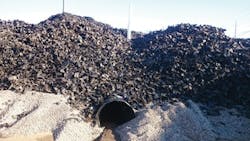About the author: Jill Brown is a freelance writer. Brown can be reached at [email protected].
The site of the old Midway Stadium in St. Paul, Minn., is home to one of the largest civil engineering applications of recycled tire engineered aggregate (R-TEA) in Minnesota. More than 1 million tires, or approximately 20% of a year’s worth of discarded tires in Minnesota, are finding new life protecting the Mississippi River from storm water runoff.
Where people once tailgated before baseball games, companies are unloading their moving vans and setting up shop in a new 190,000-sq-ft commercial and light industrial office warehouse project.
Unbeknownst to many of the tenants and customers, the parking lot is resting on an underground storm water filtration and storage system made from R-TEA. The tire shreds capture sediment and store the water for slow absorption into the ground.
Recycled tire engineered aggregate is compacted by tracked machines.
Stepping Up to the Plate
The Saints baseball team played in Midway Stadium for 22 years. During that time, water ran over the surface to a 7-ft-diameter pipe that dumped water and sediment directly into the Mississippi River.
Because the site was once a landfill for the state fairgrounds, St. Paul Port Authority required a Response Action Plan to remediate it as a potential source of pollution for groundwater and surface water.
This was not a small landfill. Today, the 12-day-long Minnesota State Fair is one of the region’s most widely attended tourist activities, drawing about 1.8 million visitors each year. Located next to the Midway Stadium site on 320 acres, it is one of the nation’s biggest fairs.
Extensive cleanup of the site occurred in 2015. At the beginning of 2016, the storm water management system was installed. LHB Corp. designed the system using R-TEA supplied by First State Tire Recycling of Isanti, Minn.
A SAFL baffle, pervious pavers and approximately 30,000 cu yd of R-TEA work together to pretreat water by removing sediment. The system is designed to infiltrate the runoff volume from a 100-year storm event.
LHB Corp. project documents describe the advantages of using tire-derived aggregate (TDA) as fill for storm water systems: “The use of TDA as a storage facility for storm water treatment provides an environmentally safe reuse of tires that would otherwise be discarded as waste."
The project documents explain, “[TDA] offers a reduced-cost alternative to the typical stone aggregate and chamber systems that are commonly used for below-grade storm water storage. In addition to conserving natural resources, TDA can greatly reduce the cost of construction for underground systems.”
Many developers prefer to have their storm water systems underground to save valuable real estate space. The use of TDA in civil engineering has its roots in road construction and site foundation stabilization. R-TEA’s engineering properties make it ideal for supporting heavy developments. It is lightweight with high shear strength, large void space and good thermal insulation.
Citywide Solution
With the assistance of the Minnesota Pollution Control Agency and other entities, St. Paul Port Authority has turned 21 polluted and abandoned inner-city sites into environmentally friendly business centers.
In 2010, St. Paul Port Authority installed a storm water system that set a precedent in sustainable engineering. Formerly the home of 3M Co. factories, the land now hosts 650,000 to 700,000 sq ft of new buildings. Within the land, engineers connected new 10-ft-diameter metal culverts to the existing Phalen storm water tunnel.
As backfill to surround the metal culverts, 7,725 cu yd of R-TEA was installed. The system now eliminates more than 90% of the runoff sediment from 163 acres of St. Paul East Side that previously flowed untreated into the Mississippi River. The project won numerous awards, including the American Council of Engineering Companies’ (ACEC) Grand Award and 2012 People’s Choice Award in ACEC’s Engineering Excellence Award Competition. Jill Brown is a freelance writer. Brown can be reached at [email protected].
The parking lot for the new Tierney Brothers Inc. headquarters is constructed on top of the storm water system.
